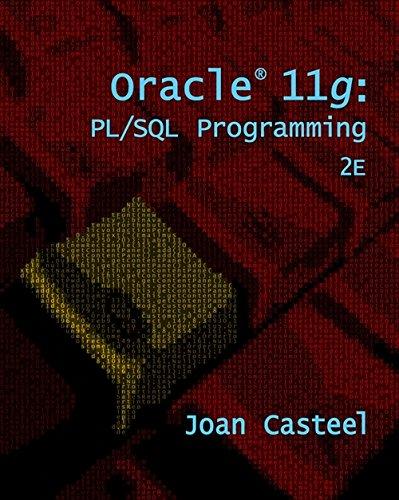Question
Use the following directed graph. A: to B is 4 & to F is 2 B: to A is 1 & C is 3 &
Use the following directed graph.
A: to B is 4 & to F is 2
B: to A is 1 & C is 3 & to D is 4
C: to A is 6 & to B is 3 & to D is 7
D: to A is 6 & to E is 2
E: to D is 5
F: to D is 2 & to E is 3
a) Do Dijkstra's shortest path algorithm starting with C ending with E. Trace the algorithm using the same format as I use. Replace ?s and give the table per step.
Initially:
Tree has: C
Fringe (F*) has: A6, B3 and D7
DistTo of these are initialized to be the edge weights from C.
__________________________
DistTo CandidateEdge
T* C 0 start
F* A 6 from C
F* B 3 from C
F* D 7 from C
E inf
F inf
________________________
Step1:
Pick B (show that B is T* in the table)
B is next to A1, C3, D4.
Note that C is already *T.
Note that A and D are already in Fringe. Should we update them?
DistTo to these vertices when going through B:
DistTO[A] = DistTo[B] + 1 = 4 update (it is better)
DistTO[D] = DistTo[B] + 4 = 7 no change (it is not better)
DistTo CandidateEdge
T* C 0 start
F* A 4 from B updated
T* B 3 from C
F* D 7 from C unchanged
E inf
F inf
Step 2:
Pick A (show that it is T* in the table)
A is next to: F, B (show that they are F* if not already)(ignore if already *T)
DistTo to these Fringe (F*) vertices when going through A:
DistTO[F] = DistTO[A] + weight(A,F) = 6 update
(Update the table and indicate new or updated or unchaged in the table)
___________________________________
DistTo CandidateEdge
T* C 0 start
T* A 4 from B updated
T* B 3 from C
F* D 7 from C unchanged
E inf
F* F 6 from A new
________________________________________
Step 3:
Pick F (show that it is T* in the table)
F is next to: E,D. D is in the fringe (show that they are F* if not already)(ignore if already *T)
DistTo to these Fringe (F*) vertices when going through F:
DistTO[E] = DistTO[F] + weight(F,E) = 9 update
(Update the table and indicate new or updated or unchaged in the table)
_______________________________
DistTo CandidateEdge
T* C 0 start
T* A 4 from B
T* B 3 from C
F* D 7 from C
F* E 9 from F new
T* F 6 from A updated
____________________________________
Step 4:
Pick ?? (show that it is T* in the table)
?? is next to: ??? (show that they are F* if not already) (ignore if already *T)
DistTo to these Fringe (F*) vertices when going through ??:
DistTO[D] = DistTO[C] + weight(C,D) = 9 no change
(This is the updated table)
____________________________
DistTo CandidateEdge
T* C 0 start
T* A 4 from B
T* B 3 from C
T* D 7 from C
F* E 9 from F new
T* F 6 from A updated
______________________________________
Step 5:
Pick ?? (show that it is T* in the table)
?? is next to: ??? (show that they are F* if not already) (ignore if already *T)
DistTo to these Fringe (F*) vertices when going through ??:
DistTO[??] = DistTO[???] + ??? = ????
(This is the upadated table)
DistTo CandidateEdge
T* C 0 start
T* A 4 from B
T* B 3 from C
T* D 7 from C
T* E 9 from F updated
F* F 6 from A
Stop as soon E becomes *T.
Step by Step Solution
There are 3 Steps involved in it
Step: 1

Get Instant Access to Expert-Tailored Solutions
See step-by-step solutions with expert insights and AI powered tools for academic success
Step: 2

Step: 3

Ace Your Homework with AI
Get the answers you need in no time with our AI-driven, step-by-step assistance
Get Started


